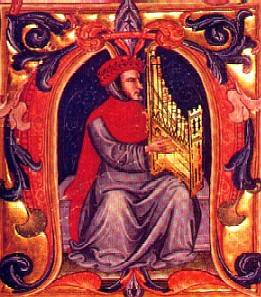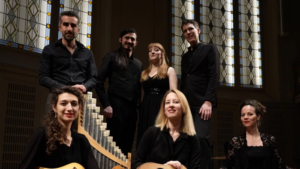
Detail of Francesco Landini wearing a corona laurea while playing an organetto in an illustration from the 15th-century Squarcialupi Codex.
Each week , we’re presenting a tiny taste of the BFX—an amuse-bouche for the upcoming Festival feast!
* * * * *
The Trecento—short for “milletrecento” (1300)—refers to the fourteenth century, but more specifically to the arts in Italy: painting, sculpture, architecture, literature, and, of course, music, all flourished during this point in Italy’s history. Leonardo, Michaelangelo, Dante, Petrarch, Boccaccio, and many others, including composer Francesco Landini, were active during the Trecento.
There was a constant interchange of ideas and musicians between Italy and France during this period; “Ars Nova” and “Trecento” became almost interchangeable terms in some circles as the same types of innovations were being shared and utilized freely. As an example, the under-third cadence, involving the melodic drop from the seventh to the sixth before going up again to the octave, became known as the Landini Cadence after Landini, the most famous composer of the time, because of its frequent use in his music. It can be found in most of the music of the period, especially after him, attesting to this sharing of musical influences among composers.
In contrast to the other arts, Trecento music had a greater flowering in the latter half of the fourteenth century (and in fact is often considered to extend well into the fifteenth century, ending around 1420). But flower it did: in addition to Landini, Italy produced a number of composers whose works can still be heard today, including Niccolò da Perugia, Lorenzo da Firenze, and Donato da Cascia.
* * * * *
 On Tuesday, June 7 at 7 PM, come hear the composers of the Trecento in a concert by the Basel-based SOLAZZO ENSEMBLE.
On Tuesday, June 7 at 7 PM, come hear the composers of the Trecento in a concert by the Basel-based SOLAZZO ENSEMBLE.
Learn more, and get tickets for the BFX, here: https://berkeleyfestivalarchive.com/2022-main-stage/

Comments are closed.